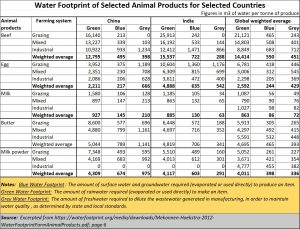https://www.moneycontrol.com/news/business/economy/india-forgot-about-the-water-footprint-4155691.html
India forgot about the water-footprint
Water series #7 — other articles in this series are listed below
RN Bhaskar – 1 July 2019
In November 2004, UNESCO brought out a series of papers compiled by A.Y. Hoekstra which were aimed at making the world understand how to look at the water footprint for almost every product. By October 2008 these papers led to the formation of the Water Footprint Network by a number of major global players from business, civil society, multilateral organizations and academia (https://waterfootprint.org/en/resources/interactive-tools/product-gallery/) . This Network strives to support the transition to sustainable and equitable water use and management globally.
 The Network recognised that most governments “have a blind spot to the issue of sustainability of national consumption”. It believed that governments can and should engage with consumers and businesses to work towards sustainable consumer products.
The Network recognised that most governments “have a blind spot to the issue of sustainability of national consumption”. It believed that governments can and should engage with consumers and businesses to work towards sustainable consumer products.
The Network believes that national water footprint accounting should be a standard component in national water statistics. This type of accounting ought to provide a basis to formulate national water plans and river basin plans that are coherent with national trade policy and national environmental policy.
The Network also underscored the major difference between a carbon footprint and a water footprint. A carbon emission in one place, it said, can be offset by carbon emission reduction or sequestration in another place. This is not true of water. One cannot reduce the local impact of water use in one place by saving water in another place. Each area has to be looked at separately, as water tables cannot be averaged with other water tables and river basins. This is where averages just don’t work.
There was another realisation. While it is possible to give an indicative estimate of the water footprint for each item – steel, copper, or even farm or animal produce, the water footprint could change from region to region (https://waterfootprint.org/en/water-footprint/product-water-footprint/water-footprint-crop-and-animal-products/).
As one begins to take into account the amount of water used (even evaporation is taken into account) right from the time of the seed being put in the soil to the time when the fruit is ready for consumption, one also realises that the water consumed may have little to do with nutritional value. That is why, countries sometimes need to look at the water footprint of products, and decide which of these products ought to be produced within a country’s territory, and which ought to be imported to ensure that too much of water is not consumed. That is where water footprint accounting becomes critically important. This is because fresh water is vital to life. As the world grows, so does its population, and so does the use of water. It takes lots of water to produce anything: food, energy or even consumer products. The water used in its life cycle is also known as virtual water (https://www.watercalculator.org/footprints/what-is-a-water-footprint/).
 To understand the kind of water used, it is clubbed under three heads:
To understand the kind of water used, it is clubbed under three heads:
Blue Water Footprint: This refers to the amount of surface water and groundwater required (evaporated or used directly) to produce an item.
Green Water Footprint: The amount of rainwater required (evaporated or used directly) to make an item.
Grey Water Footprint: The amount of freshwater required to dilute the wastewater generated in manufacturing. This is done in order to maintain water quality, as determined by state and local standards.
So how does India compare on this front? An illustrative table might be useful here.
Study the table above. Except for milk and milk related products, China has shown itself to be a better manager of all three types of water – green, blue and grey — for a variety of products. But when compared to world averages, India slips even on the milk front.
India has no idea of how much water it uses (https://www.moneycontrol.com/news/india/water-water-everywhere-nor-any-drop-to-drink-4082681.html). And without first knowing the amount of water used, how can it devise policies on which products should be encouraged in India and which should be discouraged? It is only when one knows how much water is consumed for making a product can the government come out with policies on how to charge for water based on the product that is sought to be manufactured (https://www.dnaindia.com/business/report-policy-watch-should-individuals-groups-or-cos-charged-for-water-consumption-1994088).
For instance, even though beef has been shown to be a big guzzler of water in table 1, it does not take into account the milk that people consume from the cow after it has been milked. Net it off, and the beef situation in India may not be as bad as it seems from table 1. But when meat is grown only for consumption of meat (as in many developed countries), there is where the water footprint becomes serious when it comes to bovine flesh. Do visit the www.waterfootprint .org website. You will find more studies on China’s water footprint than India’s (https://waterfootprint.org/en/resources/publications/value-water-research-report-series-unesco-ihe/).
Well governed nations know how to use the water footprint tables and then study the comparative advantages involved in producing the item at home, or procuring it from elsewhere. Some of the documents which can be used for making such measurements possible can be found at https://waterfootprint.org/en/resources/interactive-tools/product-gallery/.
India has a long way to go before it can even try and claim that it understands how to use water. As mentioned in the earlier articles in this water series, India has not even begun measuring the amount of water consumed by individuals and by farms. The water footprint is a significant advancement over (the absence of) these measurements.
Maybe, the impending drought will make the government’s administrators sit up and finally begin applying policies that ought to have been part of public debate almost a decade ago.
Articles in this series:
Water Series 1 – http://www.asiaconverge.com/2019/05/india-faces-a-water-crisis-of-its-opwn-making/ – India’s rapidly deteriorating water crisis
Water series 2 – http://www.asiaconverge.com/2019/05/india-should-learn-water-management-from-china/ — Lessons to learn from China
Water series 3 — http://www.asiaconverge.com/2019/06/the-stranglehold-of-the-water-tanker-mafia/ — The stranglehold of the tanker-mafia
Water series 4 — http://www.asiaconverge.com/2019/06/india-faces-water-shortage-despite-abundance/ — Water, water everywhere// Nor any drop to drink
Water series 5 — http://www.asiaconverge.com/2019/06/crisis-helps-review-water-policies/ — Crisis alone can make water policies change
Water series 6 — http://www.asiaconverge.com/2019/06/climate-change-depleting-reservoirs-and-the-blindness-to-water-treatment-and-recycling/ — Climate-change, depleting reservoirs and the blindness to water treatment and recycling
Water series 7 — http://www.asiaconverge.com/2019/07/how-india-forgot-its-water-footprint/ — How India forgot its water-footprint
Water series 8 — http://www.asiaconverge.com/2019/07/india-faces-no-scarcity-of-water/ — Water scarcity is a myth India loves to propagate
Water series 9 – http://www.asiaconverge.com/2019/07/the-govt-fails-in-water-harvesting-and-waste-management/ — The govt slips up badly on waste management, even water harvesting
Water series 10 — http://www.asiaconverge.com/2019/07/water-and-waste-management-key-to-pm-plans/ — Petty graft could sabotage water and waste management and even the PM’s biggest schemes
Water series 11 — http://www.asiaconverge.com/2019/07/niti-aayog-is-promoting-desalination-which-is-irrelevant-expensive-and-polluting/ — Desalination: Niti Aayog shouldn’t push a solution that is irrelevant, expensive and polluting
Water Series 12 — http://www.asiaconverge.com/2019/08/desalination-is-a-money-game-in-india/ — Desalination is a big money game baby!











































COMMENTS